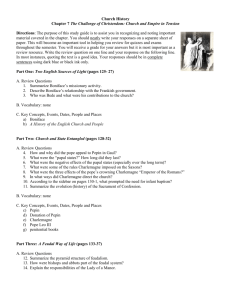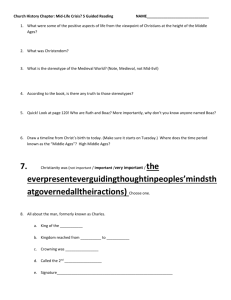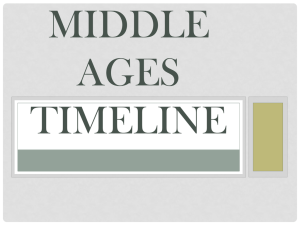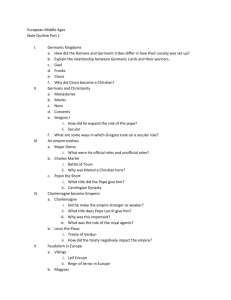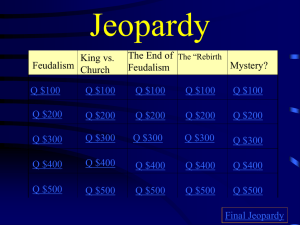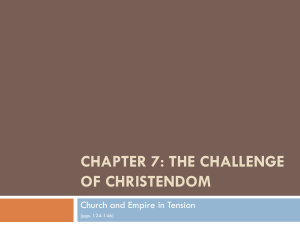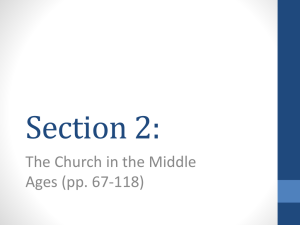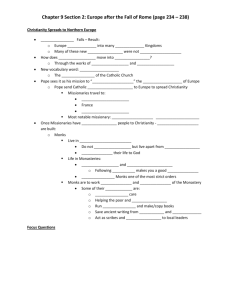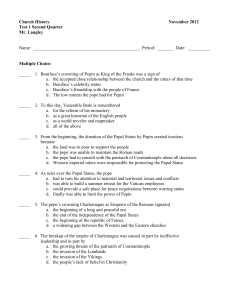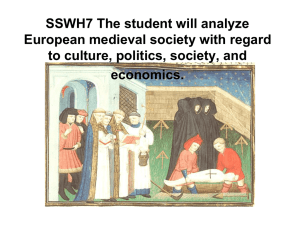the early middle ages 600 - 1050ad 6
advertisement
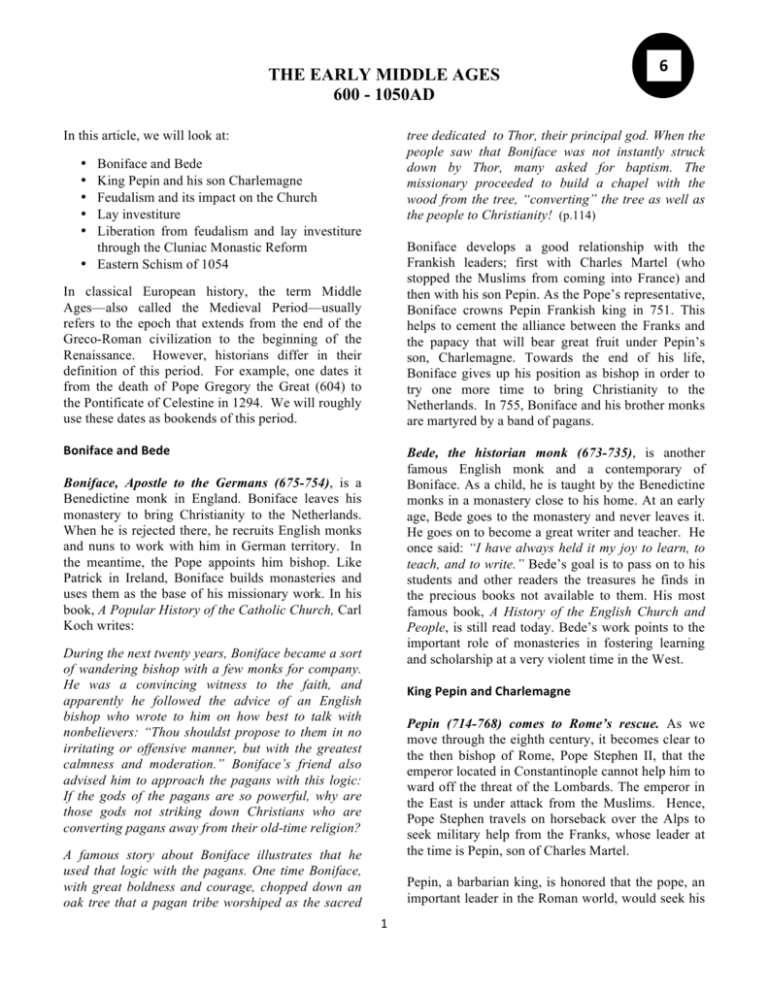
THE EARLY MIDDLE AGES 600 - 1050AD In this article, we will look at: tree dedicated to Thor, their principal god. When the people saw that Boniface was not instantly struck down by Thor, many asked for baptism. The missionary proceeded to build a chapel with the wood from the tree, “converting” the tree as well as the people to Christianity! (p.114) Boniface and Bede King Pepin and his son Charlemagne Feudalism and its impact on the Church Lay investiture Liberation from feudalism and lay investiture through the Cluniac Monastic Reform • Eastern Schism of 1054 • • • • • Boniface develops a good relationship with the Frankish leaders; first with Charles Martel (who stopped the Muslims from coming into France) and then with his son Pepin. As the Pope’s representative, Boniface crowns Pepin Frankish king in 751. This helps to cement the alliance between the Franks and the papacy that will bear great fruit under Pepin’s son, Charlemagne. Towards the end of his life, Boniface gives up his position as bishop in order to try one more time to bring Christianity to the Netherlands. In 755, Boniface and his brother monks are martyred by a band of pagans. In classical European history, the term Middle Ages—also called the Medieval Period—usually refers to the epoch that extends from the end of the Greco-Roman civilization to the beginning of the Renaissance. However, historians differ in their definition of this period. For example, one dates it from the death of Pope Gregory the Great (604) to the Pontificate of Celestine in 1294. We will roughly use these dates as bookends of this period. Boniface and Bede Bede, the historian monk (673-735), is another famous English monk and a contemporary of Boniface. As a child, he is taught by the Benedictine monks in a monastery close to his home. At an early age, Bede goes to the monastery and never leaves it. He goes on to become a great writer and teacher. He once said: “I have always held it my joy to learn, to teach, and to write.” Bede’s goal is to pass on to his students and other readers the treasures he finds in the precious books not available to them. His most famous book, A History of the English Church and People, is still read today. Bede’s work points to the important role of monasteries in fostering learning and scholarship at a very violent time in the West. Boniface, Apostle to the Germans (675-754), is a Benedictine monk in England. Boniface leaves his monastery to bring Christianity to the Netherlands. When he is rejected there, he recruits English monks and nuns to work with him in German territory. In the meantime, the Pope appoints him bishop. Like Patrick in Ireland, Boniface builds monasteries and uses them as the base of his missionary work. In his book, A Popular History of the Catholic Church, Carl Koch writes: During the next twenty years, Boniface became a sort of wandering bishop with a few monks for company. He was a convincing witness to the faith, and apparently he followed the advice of an English bishop who wrote to him on how best to talk with nonbelievers: “Thou shouldst propose to them in no irritating or offensive manner, but with the greatest calmness and moderation.” Boniface’s friend also advised him to approach the pagans with this logic: If the gods of the pagans are so powerful, why are those gods not striking down Christians who are converting pagans away from their old-time religion? King Pepin and Charlemagne Pepin (714-768) comes to Rome’s rescue. As we move through the eighth century, it becomes clear to the then bishop of Rome, Pope Stephen II, that the emperor located in Constantinople cannot help him to ward off the threat of the Lombards. The emperor in the East is under attack from the Muslims. Hence, Pope Stephen travels on horseback over the Alps to seek military help from the Franks, whose leader at the time is Pepin, son of Charles Martel. A famous story about Boniface illustrates that he used that logic with the pagans. One time Boniface, with great boldness and courage, chopped down an oak tree that a pagan tribe worshiped as the sacred Pepin, a barbarian king, is honored that the pope, an important leader in the Roman world, would seek his 1 6 help. Pepin not only defeats the Lombards, but gives the Pope a large tract of land which becomes known as the Papal States and which remains an independent country under the rule of the papacy until 1870. The Donation of Pepin—as his gift was called—has some negative results: Evangelizer by the sword. In the 43 years of his reign, Charlemagne is at war 42 years, conquering many people and giving them a choice to be baptized “by water” or “by blood.” This means that Catholicism now has a huge number of unevangelized and uncatechized members. It is an age when illiterate people follow or are forced to follow the religion of their ruler. In this period of Church history, the hope of preserving civilization and instructing the ignorant in their faith lie primarily with monasteries. • It has infuriated the Byzantines (Eastern political and Church leaders) who claim that some of the land given to the Pope belongs to them. • It has created a built-in tension with future Western rulers. The Frankish kings believe that by becoming papal protectors, they gain the right to tell the popes how the Church should be governed. Because they act like secular rulers, the popes will be treated accordingly. We see this especially in the case of Pepin’s son, Charlemagne. Educator. Even though he himself is practically illiterate, Charlemagne realizes the importance of education. At his palace in Aachen, Charlemagne starts a school headed by the English monk Alcuin, who had been a pupil of Bede in England. Alcuin becomes Charlemagne’s teacher and sometimes his conscience, challenging him whenever he behaves in an unchristian way. The school attracts the best teachers from all parts of the empire. Charlemagne insists that schools be attached to every cathedral and monastery for the education of the nobility. He encourages the copying of ancient manuscripts. He builds many Benedictine monasteries. • Owning a huge tract of land forces the Pope into a political and material role, often causing him to lose sight of his spiritual role. Charlemagne (742-814). Like his father Pepin, Charlemagne—also known as “Charles the Great”— defends Rome from a Lombard invasion. Pope Leo III is so grateful to Charlemagne that he gives him the title “Protector of the Papacy.” At Christmas Mass in Rome in 800, Leo crowns Charlemagne Holy Roman emperor. This event confers a ‘holy’ status on the new empire and emperor. Church and State are seen as almost one. The new Holy Roman Empire includes a territory that is present-day Europe, but it is ruled from Aachen (Germany). Involvement with Church governance. Charlemagne feels a strong sense of responsibility for the faith of his Christian subjects. This involves appointing educated bishops and sending them out across the empire. He also tries to educate and reform native clergy who are prone to moral corruption. Charlemagne also gets involved in the liturgical life of the Church, adopting the Latin liturgy used in Rome believing it gives dignity to the liturgy even though the vast majority of the people no longer speak Latin. He inspires the growth of Romanesque architecture and sculpture. He builds the beautiful basilica of Aix-la-Chapelle. Charlemagne’s work in the field of education, the arts and the liturgy becomes known as the Carolingian Renaissance. The creation of a new Holy Roman Empire only widens the rift between Constantinople and Rome, between Eastern and Western Catholicism. In theory, the Byzantine emperor is ruler of the West even though he is unable to help to defend it or give it aid. The pope’s crowning of Charlemagne as Holy Roman Emperor is a clear signal that Rome is breaking away from the East, at least politically. Few historians challenge Charlemagne’s claim to greatness as a major constructive figure of world history. After three centuries of disorder, he restores a good deal of law and order. His patronage of learning leaves a cultural heritage that later generations can build up on. Charlemagne causes further division between Eastern and Western Christianity when he compels the Eastern Church to add a new phrase, filioque, to the Nicene Creed. The Creed originally states that the Holy Spirit proceeds from the Father. The Western version which Charlemagne advocates (based on the theology of St. Augustine) affirms that the Holy Spirit proceeds from the Father and the Son (filioque). Sadly, Charlemagne’s great empire is not long-lived. His successors are weak and unable to hold together the vast territories ruled by powerful nobles. Moreover, as the Vikings begin to appear on the scene, people increasingly surrender both their lands and 2 persons to the many counts, dukes and other lords in return for protection. These disintegrating conditions present a new challenge to the Church and to the unity of Europe, and creates a new ideology called feudalism. After Charlemagne’s death, the system of feudalism becomes the dominant social, political and economic way of life in Europe. Writing about the negative impact of feudalism on the Church, Anthony Giles states: Many, if not most bishops and priests during this time were married and had large families. Their interest in a Church office was often political rather than spiritual. Under Teutonic law, the man who owned the land on which the church was located was also seen as the owner of the church and supervisor of its affairs. Sometimes this landowner was the bishop himself. In that case, the bishop often did not consider himself called to a uniquely spiritual office. Rather, he saw himself as part warrior, part landowner, part imperial servant – and, oh yes, part bishop. Feudalism and its impact on the Church In his book, A Popular History of the Catholic Church, Carl Koch describes the pyramid of feudalism in this way: Feudalism was a political and economic system based on a pyramid structure. At the bottom of the pyramid were the serfs, or peasants, who worked a piece of land in return for food and housing. The vast majority of people in Europe were serfs whose status was little above that of a slave. Next above the serfs was their immediate landlord and boss. This middlelevel boss was considered a lord to his serfs but a vassal to his own higher lord (a vassal was one who pledged loyalty to a higher lord, or overlord). The higher lord, who owned the whole feudal estate (fief or manor), protected his vassals in return for their military service in his small army of fighting horsemen. Further up, at the top of the feudalism pyramid, was the king, who was the grand landlord of his region. Such men wanted more than anything to protect their own interests. They saw to it that their churches were bequeathed to their sons. This often led to scandalous fights between rival claimants to a deceased bishop’s office – brother against brother, nephew against son, etc. Then, too, families often would compete with one another to buy a vacant episcopal chair. One can point to numerous illustrations of this sin of simony – buying and selling of Church offices. One notorious nobleman, for example, outbid an abbot for a vacant bishop’s seat, paying today’s equivalent of over ten million dollars for the office and then giving it to his ten-year-old son, making his ten-year-old son bishop. (The People of God – the History of Catholic Christianity, pp 42-43) Regional kings warred against one another, and within any one region, rival lords and knights waged their own private wars. Roads were mere paths, and travelers were frequently held up by robbers. Many lords demanded payment of tolls from people passing through their lands. Then, too, the seacoasts, areas near rivers, and border territories were being invaded by waves of Vikings. The situation was chaotic and dangerous. Lay Investiture Anthony Giles describes lay investiture in this way: Lay investiture was a procedure by which laymen – princes, counts, dukes, or other powerful lords – would invest bishops and abbots with their insignia of office. Imagine today for example, a new bishop being installed, not by his brother bishops, but by the mayor of Boston or the Governor of New York. Such a procedure obviously contradicts what is actually taking place – the passing of spiritual authority from one bishop to another. Lay investiture was a public statement to the effect that the state had the authority to regulate the Church’s life. (ibid, p.43) The church had a major role in the feudal system. Bishops and abbots of monasteries were often powerful lords of feudal estates. Most bishops and monasteries had large landholdings, usually given to them by lords or kings over long periods of time. Many bishops and some abbots and abbesses were appointed to their church offices by kings. During the feudal period, the church actually became the largest landowner in Europe. One monastery in Germany had enough land to support fifteen thousand manors, and a French bishop at Tours ruled about twenty thousand serfs. (pp 120-123) The Papacy. In general, the papacy from the ninth through the first half of the eleventh century is filled with corruption. Because the Pope rules the Papal States, the office becomes desirable for the dominant noble families who want to rule these lands. Thus, powerful noble families vie for control of the papacy, 3 manipulating papal elections in scandalous ways, at times putting adolescents and the most incompetent people on the throne of St. Peter. The fact that the Church during this period did not veer from true doctrine or morals and that it survived this era of papal corruption is proof that Christ is indeed faithful to his promise to be with his Church (Mt 28:20). Two other great popes in this era, Urban II and Paschall II, were originally monks of the Cluniac Reform. The Eastern Schism of 1054 The problematic relationship between the Western Church and the Eastern Church culminates in 1054. Liberation from feudalism through the Cluniac Monastic Reform • The distance between Rome and Constantinople makes for difficult communication. They literally speak two different languages. The East speak Greek only while the West speak Latin only. With abbots and bishops answering to local secular powers such as dukes and counts, corruption among Church officials runs rampant. However, a new light in the darkness of feudalism starts to shine when a layman and duke, William of Aquitaine, donates land for a new Benedictine monastery in Cluny, France. William insists that the monastery be independent of any control by a local lord or secular ruler. The monks are to select their own abbot who will only answer to the pope. By coming under the authority of the pope who is outside the feudal system, Cluny breaks with feudal tradition and opens the way for the Church to liberate itself from civil control. • They celebrate the liturgy in two different languages and gradually develop different ways of celebrating the liturgy. • Politics is a huge reason for the growing hostility and eventual split. Constantine moves his capital from Rome to Constantinople. The reigning Eastern emperor appoints the patriarch of Constantinople (head bishop of the East) who becomes subject to the emperor. In contrast, the popes in the West do a better job of asserting their rights against the State. Concerning the impact of Cluny, Michael Pennock writes: Prayer was to be the primary activity, and a strict observance of Benedict’s Rule was the norm. Serious Christian discipleship, sacrifice, and generosity to the poor became the hallmarks of the Clunaic lifestyle. • The patriarch of Constantinople is to the Eastern Church what the pope is to the Western Church. While the patriarch recognizes Rome’s primacy of honor because Peter had died there, he does not recognize his primacy of jurisdiction, his right to rule over the Eastern Church. As a result, Cluny became a fountainhead of reform activity. It founded many daughter monasteries, answerable only to Cluny. This helped unify Christian communities all over Europe and wrested some control of the Church from the secular authorities. Within two hundred years, more than twelve hundred monasteries adopted Clunaic reforms. • When the pope seeks military help from Pepin and the Franks because the Eastern emperor can no longer provide him protection against the barbarians, the division between Rome and Constantinople widens. Furthermore, when Pepin grants the pope a large tract of land in Italy, the Eastern emperor resents it because he believes that at least some of that land belongs to him. Several able abbots from Cluny, for example, Odo and Odilo, called for a general reform in the Church. Free from the clutches of feudalism, the reforms begun at Cluny eventually influenced some strongminded reformers. One of these was Hildebrand, a future Pope (Gregory VII) who would win back for the Church much of the spiritual authority lost in the Dark Ages. (This is Our Church, p.105) • The iconoclasm (“image breaking”) issue also widenes the rift between Rome and Constantinople. In 726, the Eastern Emperor Leo III orders the destruction of all sacred images because he believes that their veneration is a form of idolatry. When the pope refuses to go along with Leo’s decree, he becomes so furious that he sends an army to attack Rome. Fortunately, for Rome, a huge storm sinks Leo’s fleet of ships. Eventually, the Second Council of Nicaea (787) will support the pope’s view. The 4 Council’s decision will help to bolster the role of the bishop of Rome as the prime teacher of the faith for the whole Church. understandably infuriated and will not soon forget what the Western Church has done. Efforts to heal the split at various church councils fail. • Doctrinally, the phrase filioque (“through the Son”) which the Western Church has added to the Creed is another issue that separates the two churches. The Eastern Church resents this addition as it believes that God the Holy Spirit came through the Son and not from the Son. Our current Nicene Creed states the “Holy Spirit comes to us from the Father and the Son.” In 1965, Pope Paul VI meets with Patriarch Athenagoras I. They lift the ban of mutual excommunications imposed in 1054. In 2001, Pope John Paul II apologizes for the Catholic involvement in the siege of Constantinople. At the installation Mass of Pope Francis, the Patriarch is present and exchanges the kiss of peace with the new pope. Finally, it should be noted that over twenty Eastern Catholic Churches with their own ancient traditions and customs are in union with Rome. For all of the above reasons, the relationship between the Eastern and Western churches was very poor for many centuries. Discussion questions The final split comes in the eleventh century when the popes finally emerge from being under the control of the German emperor, and start to assert their authority over the whole Church. In 1054, the hot-headed Michael Cerularius becomes the patriarch of Constantinople. He has a very anti-Latin attitude and forbids all celebration of the Mass in Latin in his territory. When Pope Leo IX sends some representatives to Constantinople to discuss this issue and others with the Patriarch, he keeps them waiting for three months before seeing them. When they finally meet, the pope’s representatives, led by Cardinal Humbert, another hothead, demand that Cerularius recognize the Pope as the head of the whole Church. When he refuses, Humbert excommunicates Cerularius. In turn, Cerularius convokes a Council and excommunicates the Pope. The Eastern Church sides with the patriarch and refuses to recognize the primacy of the Pope. They eventually take the name Orthodox (“correct or right teaching”). At the time of the double excommunication, most Christians in the Eastern and Western churches probably did not notice the schism, thinking that it was just another bad moment in the relationship between both sides. Nevertheless, a split takes place. In 1204, an event happens that deepens the split: Crusaders are sent to Constantinople to help Eastern Christians defend themselves against the Muslims. Instead of helping their Christian brothers and sisters, they end up sacking and pillaging Constantinople, proclaiming the Western emperor King of Constantinople and installing a Latin bishop as patriarch of that city. Eastern Christians are 5
